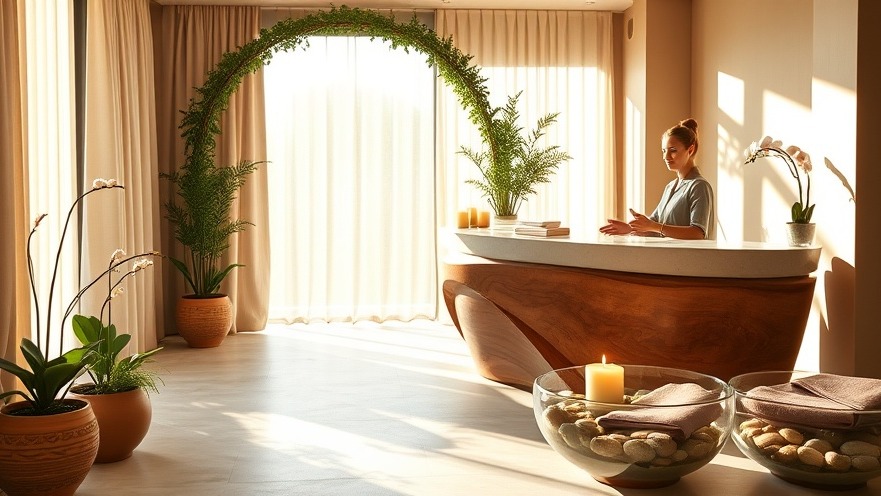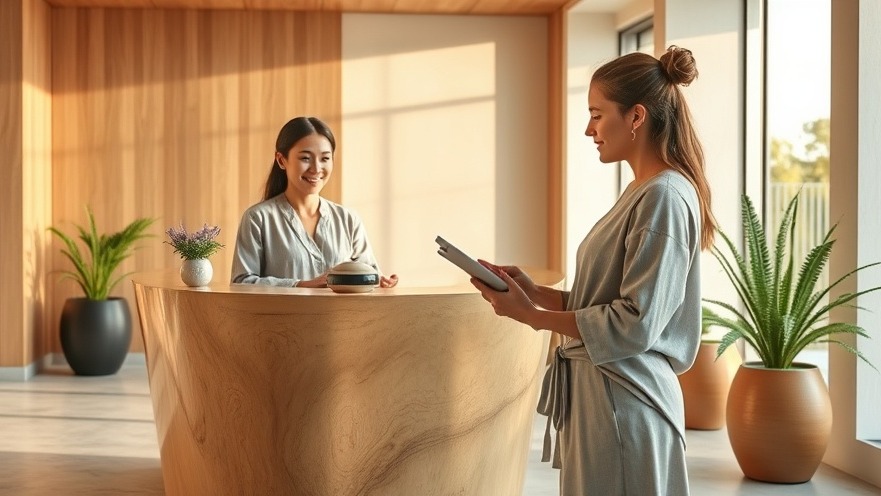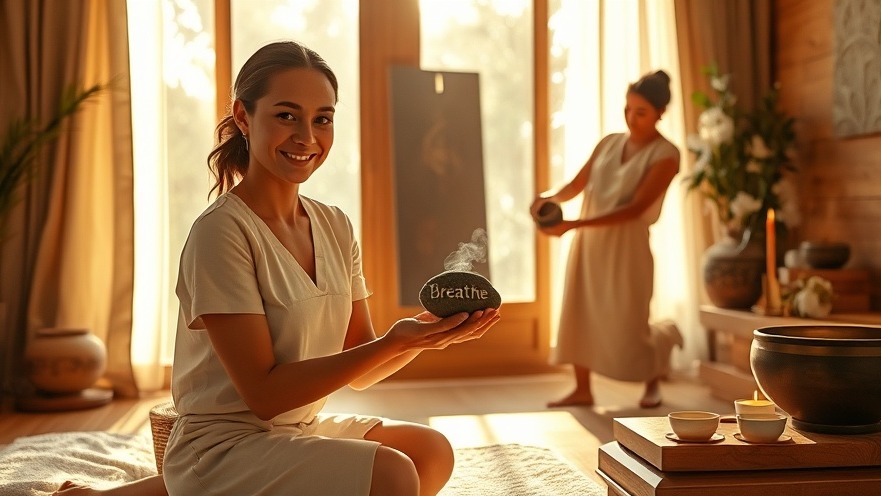
The Energy Guests Feel Before a Word Is Spoken
Before the robe, before the oils, before the music even fully registers — something far more powerful is already at work.
It’s the scent of bergamot drifting through the air. The quiet way a voice says, “Welcome in.” The way a guest’s shoulders drop ever so slightly when they realize they’ve stepped into safety.
Those first five minutes are more than a greeting — they’re an emotional handshake. And in the spa world, that handshake is everything.
Behavioral science calls it the Peak–End Rule: people remember how experiences begin and how they end more than anything that happens in between. For spas, that means the tone of your opening moments doesn’t just set the mood — it defines the memory.
As one spa director shared during our conversation, “Our welcome is part of the therapy. From the first breath they take inside our doors, we’re already shifting their nervous system.”
That shift — from routine to ritual — is what separates good service from transformative care.
A Tradition Rooted in Healing
Long before spas became modern sanctuaries, the art of welcome was woven into every healing practice. Ancient bathhouses and temples of wellbeing often began with rituals of cleansing — hands washed, herbs burned, a greeting that symbolized renewal.
Modern hospitality adopted those same principles. The Ritz-Carlton’s “Three Steps of Service” — a warm greeting, anticipation of needs, and a fond farewell — became the gold standard for meaningful human connection.
Over time, these traditions evolved into what spa leaders now call the guest journey.
“The goal,” says customer-experience author Joseph Michelli, “isn’t to impress your guest — it’s to center them.”
Spas took this to heart. They realized the first five minutes could function as emotional alignment — a way to draw guests inward and prepare them for the deeper work of rest and restoration.
What began as a formality turned into a philosophy: the welcome itself is part of the healing.

Reinventing the Arrival: The Modern Spa’s Turning Point
When digital check-ins first appeared, efficiency was the prize. Guests could sign waivers online, skip the clipboard, and move straight to their service. But something got lost in the rush — that delicate pause between arrival and exhale.
Then came the pandemic, and with it, a new kind of awareness. Spas realized that guests weren’t just seeking pampering — they were seeking safety, reassurance, and calm. The welcome suddenly became sacred again.
Now, across the country, forward-thinking spas are crafting arrival rituals that blend technology with touch.
A text message confirming the appointment is paired with a note of gratitude.
Paperless check-ins are softened by aromatherapy diffusers and low lighting.
Hands-free greetings are balanced with deeper eye contact and slower pacing.
At one Arizona retreat, staff are trained to take a single, grounding breath before greeting each client. “The guest can feel our energy shift,” the spa manager says. “If we’re calm, they’re calm.”
It’s not about perfection — it’s about presence.
Inside the First Five Minutes
Every sensory detail in those opening moments communicates something — whether you intend it to or not.
Sight is the first language of trust. A clean, open entryway signals calm. Clutter and harsh light cue the opposite. Guests subconsciously scan for safety before they even speak.
Sound sets rhythm. A gentle playlist — ideally around 60–70 beats per minute — helps synchronize breathing and slow the heart rate. Even the tone of a front-desk voice can anchor that rhythm.
Scent is memory. A consistent signature fragrance (lavender, lemongrass, or sandalwood) ties the experience together. Studies show that pleasant ambient scent can increase customer satisfaction and dwell time and even boost spending by up to 20%. When paired with soft music, scent can reduce mental rumination and enhance perceived relaxation — helping arrivals feel smoother and more welcoming.
Touch and movement matter, too. Offering infused water, a cool towel, or a brief pause before paperwork signals care through action.
And then there’s language — that quiet art of saying less, but meaning more.
Instead of “How can I help you?” try, “Welcome in — we’ve been looking forward to having you.”
Tone, timing, and posture deliver as much as the words themselves.
A hospitality study by StayNTouch found that guest satisfaction drops by nearly half when check-in exceeds five minutes. But it’s not about the stopwatch — it’s about emotional pacing.
A guest who feels seen doesn’t count minutes. A guest who feels ignored counts every one.

What Sets Memorable Spas Apart
Every spa has a reception desk. But not every spa has a ritual.
The difference often lies in small, repeatable gestures that become part of a spa’s story.
At one coastal property, guests are welcomed with a small stone etched with words like “breathe” or “restore.” They’re invited to hold it during their service and take it home — a memento of peace.
In the mountains, a holistic wellness center greets each guest with a brief guided inhale and exhale before their intake form, teaching the body to slow down right from the start.
And in urban day spas, receptionists have replaced clipboards with warm towels and herbal tea, letting guests settle before any conversation begins.
What these places share isn’t luxury — it’s mindfulness.
Leadership expert Micah Solomon calls it “designing for feeling.” He advises teams to script the process, not the person: “Give structure, but let your staff’s personality breathe inside it.”
When spa leaders empower their teams to personalize the welcome, authenticity shines through — and guests can feel the difference.
Consistency builds trust, but sincerity builds loyalty.
Designing Your Own Five-Minute Ritual
If your welcome could speak, what would it say about you?
To turn that thought into action, start small.
Walk through your own front door as if you were a new client. Listen. Smell. Observe. Does the space invite you to pause?
From there, try implementing one change at a time:
Simplify the path. Eliminate clutter near your entryway. Visual clarity equals mental calm.
Train breathing before greeting. One deep inhale grounds your team’s tone for every hello.
Create a sensory anchor. A consistent scent or soft playlist becomes your signature.
Acknowledge emotion, not just presence. A line like, “You made it — we’re so glad you’re here,” recognizes the effort guests made to prioritize themselves.
Add a “peak moment.” A cool towel in summer, a hot one in winter, a few drops of essential oil — small gestures carry big memory.
Close as beautifully as you began. A warm farewell or handwritten thank-you card leaves the final impression guests will carry home.
Most of these changes require more mindfulness than money. They’re rooted in empathy — the art of seeing your guest not as a customer but as a human crossing a threshold.
And when your spa masters that first threshold? Everything else flows.

Turning the First Five Minutes into a Signature Moment
Every spa welcomes guests. But few truly welcome them.
The first five minutes can either mirror the chaos of the outside world or dissolve it.
They can feel like a transaction—or a transfer of calm.
Across every interview and insight, one message repeated itself: when the welcome becomes intentional, the entire experience deepens.
So start with energy, not script.
Lead with heart, not habit.
Design the space to heal the moment someone enters — not five minutes later.
Here are five takeaways to anchor in your team meetings or morning huddles:
Lead with energy, not routine. A regulated, grounded team sets the tone for the entire spa.
Design a sensory signature. Use scent, lighting, and sound to create an identity guests can feel.
Set expectations emotionally. Acknowledge wait times with warmth and honesty.
Empower personalization. Let staff adapt greetings naturally within your brand voice.
End intentionally. The farewell is as therapeutic as the welcome.
As leadership author Joseph Michelli reminds us, “A memorable experience begins the moment you stop seeing service as a checklist and start seeing it as care.”
So tomorrow morning, before your first appointment, pause.
Step through your own door as if for the first time. Feel the air, the energy, the story those first five minutes are telling.
And if that story feels calm, sincere, and human — you’ve already begun the healing.
Because in the world of spa and wellness, the true transformation doesn’t start on the table.
It starts the moment they walk through your door.
 Add Row
Add Row  Add
Add 




Write A Comment